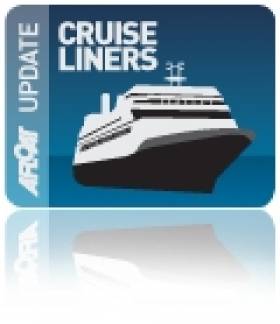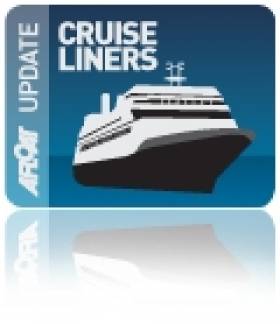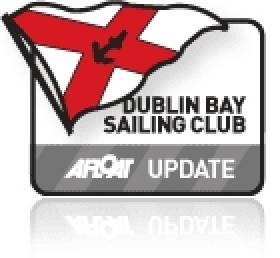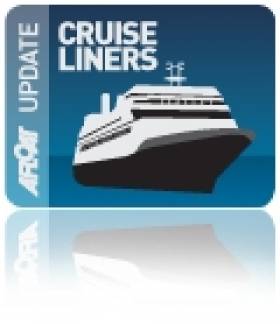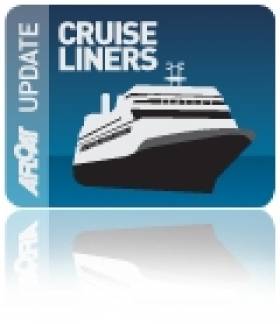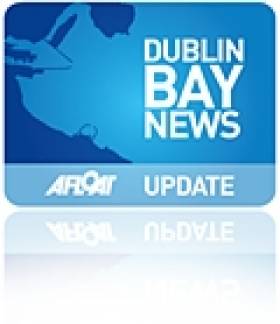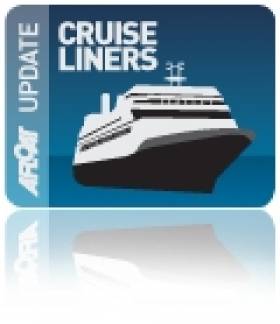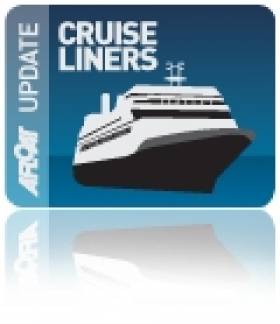Displaying items by tag: Dun Laoghaire Harbour
#CruiseTurnAround- Dun Laoghaire Harbour acted as a turnaround port of call for Windstar Cruises as the sail-assisted five-mast flagship Wind Surf ended and began fly-cruises yesterday, writes Jehan Ashmore.
Wind Surf berthed at the Carlisle Pier where passengers arrived and departed on the turnaround cruises. As she lay moored the French built ship which has 50 metre high masts stood higher than the height of the new landmark building of the DLR LexIcon Library.
Today, the 187m long vessel is on an anchorage call in Douglas Bay, Isle of Man marking the first leg of her cruise.
Cruise-goers mostly from the US and Canada had disembarked the 14,475 tons Wind Surf during her Dun Laoghaire call (albeit having arrived on Sunday, a day early than scheduled). She had begun a cruise in Lisbon, Portugal. Likewise on this current cruise passengers are in the majority from the North American market.
The Carlisle Pier is where the former conventional ferry served until 1996. In that same year the carferry was replaced by the Stena HSS fast-ferry that too came to an end with operations closing last year.
Dun Laoghaire may no longer have a ferry service with Holyhead in north Wales, though it was interesting to observe that the 'check-in' facilities for the cruise took place in the former Stena Line terminal reception hall. The terminal located on St. Michaels Wharf is adjacent to the Carlisle Pier.
A cruise representative informed me that expectant cruise-goers had flown in to Dublin Airport. Some of the visitors had spent several days in the capital in advance to embarking on the cruise.
The use of the redundant ferry terminal for the turnaround cruises has taken place in previous seasons by Windstar Cruises. The US cruise firm with corporate office based in Seattle have been the most frequent operator that is to dock inside the harbour since 2012.
#CruiseHarbour – Island Sky, the first cruiseship to dock inside Dun Laoghaire Harbour this season had requested tug assistance in preparation to berthing within the port this morning, writes Jehan Ashmore.
Overnight, the Italian built vessel with a 116 passenger capacity had sailed from Waterford city quays and upon arrival in Dublin Bay had picked up a pilot from a cutter launch around 07.30.
For around the next two hours Island Sky circled the centre of the bay before Beaufort, a Dublin Port Company tug came on the scene to escort the 4,200 tonnes vessel into Dun Laoghaire Harbour.
The requirement of the tug was understood to be precautionary due to strong winds expected inside Dun Laoghaire Harbour during the berthing of the 90m Island Sky.
It transpired the Island Sky managed to moor alongside the harbour's Carlisle Pier opposite the East Pier using her own power alone that included a bow-thruster. This avoided the services of Beaufort which saw the tug remain in attendence at close proximity.
As Island Sky came astern at Carlisle Pier a fleet of awaiting coaches were there to transport passengers to Malahide Castle. Also heard on the PA system on board the Noble Caledonia operated cruiseship was the option to take a trip into Dublin using the DART railway whilst others simply strolled to the nearby attractions of Dun Laoghaire.
Following today's shore excursion, passengers will be returning to the Island Sky which has accommodation in the form of 57 suites all with outside views and located over five decks. On the Erikson and Explorer decks these suites feature private balconies.
Asides Island Sky's call, the Dun Laoghaire Harbour Company have a further three similar 'harbour' calls scheduled but by another pair of cruiseships. Star Legend is to call twice with an interim visit by Wind Surf. The sail-assisted cruiseship has been the most frequent in port caller of recent years.
In total 18 cruiseships are due this year with the majority of the larger and deep draft cruiseships having to anchor offshore with passengers tendered ashore by launches.
If a Certain Danish Brewer Did Laser DBSC Tuesday Nights...
#dbsc – Fifteen DBSC Lasers enjoyed two races last night in a lovely warm, oscillating breeze, again within the confines of our wonderful Dun Laoghaire harbour. Race Officer Ian Matthews was on his game as usual, with square lines, course reconfigurations and no hesitation in bringing out the black flag to put manners on an ultra-eager fleet. Two great races saw a totally different top three in each, with Race 1 going to ISA Youth National Champion Conor O'Beirne (replacing bro Dan who's in Canada) followed by Gary O'Hare, then Paul Keane. Marco Sorgassi had got a peach of a start and led all the way up the first beat. Race 2 saw John Marmelstein, just returning to Lasers, take a great win, holding off Sean Craig and Patrick Cahill. No Radials adjusted into top three this time, but Shirley Gilmore took a creditable 4th in race 2. Possible highlight of this race was Rory McStay attempting to overtake O'Beirne at the downwind finish by rushing forward for a swallow dive off the bow. Interesting interpretation of the following Racing Rule/Definition ; Finish: A boat finishes when any part of her hull, or crew or equipment in normal position, crosses the finishing line from the course side. Another RStGYC instructor, Luke Murphy, also displayed fine seamanship by testing the gap between daggerboard and slot. Funnily enough there's not a lot of space in there for hand plus foil and he duly retired, blood dribbling out behind his transom !
With weather like this and 25 entries on the books so far, we must be quite close to our first 20 boat turnout. Last night followed on from an excellent Royal Alfred Bloomsday Regatta where the 17 Lasers were the largest one design fleet (dinghy or keelboat). We hope for the same or more for VDLR on July 9-12. Entry here Join us even if you can only make the weekend and remember the Thursday is a nice late start at 3.30 pm. There'll also be two discards for those juggling other commitments.
#dbsclaser - Powers that be (and Winkie Nixon!) please take note! Dun Laoghaire Harbour again served up great DBSC dinghy racing last night that would have been simply impossible either (i) Outside, given very light wind and strong tide or (ii) With a new 435 metre pier stuck in the middle of the race course, occupied or not writes Sean Craig. Like the Water Wags on a Wednesday, junior racing on a Friday, Sunday Frostbiting all winter and as with a myriad of other racing, recreational and learn to sail activities, we may see our activities decimated, scaled back and pushed outside where the risk/safety factor rises exponentially. Worth considering is that out of six DBSC Tuesday night races so far in 2015, FIVE have had to take place inside the harbour. Indeed we could have had two more inside on a windy May 12 but for the Cruise Liner shuttle service which, in fact, knocked off business an hour before our start !
The racing round-up is perhaps secondary after that but what a great little race DBSC laid on. A season's best fifteen Lasers joined a great dinghy turnout. It would have been seventeen but (no names here!) one took a wrong turn and went outside the Harbour and another young hotshot overdid his road bike training and also missed the start ! Nice to see 4 Radials out. Off a pin biased line ex 420 ace Adam Hyland nailed the start, the first beat and led for the whole first lap. Gary O'Hare was up to second after a great run. On the second beat, Sean Craig and Luke Murphy broke away and held the top two places on a dicey downwind run to the finish. Mark Coakley was always there or thereabouts and claimed third ahead of the Cahill brothers.
We are delighted to support the Royal Alfred Yacht Club "Bloomsday" Regatta this Saturday June 13. RAYC have kindly added 4.7s to the ticket and we have 2 races, first gun 1130, good après in the RSTGYC after. Online entry and now also sailing Instructions here DBSC Tuesdays resume actual Bloomsday June 16!
#AnotherCancellation– Another cruiseship has cancelled a call to Dun Laoghaire Harbour in favour of Dublin Port, bringing to four in total on what was to be a record season of 22 callers for the south Dublin Bay port, writes Jehan Ashmore.
The giant 142,000 tonnes Royal Princess with a 3,600 passenger capacity will not be making its originally scheduled call tomorrow (5th June) according to the Dun Laoghaire Harbour Company.
Instead the cancellation of the 330m (1,083ft) Royal Princess will see the Italian built ship dock in Dublin Port in the early hours of tomorrow morning. This will be her second visit to the capital port having previously cancelled an anchorage call off Dun Laoghaire only last month.
Of the 22 calls originally scheduled for Dun Laoghaire, four have cancelled, two have made visits so far (both at anchor) requiring passengers be tendered ashore. This leaves 16 cruise calls (4 to berth in harbour) remaining throughout the season ending in September.
The double successive cancellations of Royal Princess within a fortnight has further reduced Dun Laoghaire's record season of 22 cruise calls. Should however all 18 calls in total be achieved this will still be a record season for the Dun Laoghaire Harbour Company which restored the business in recent years given the backdrop of the declining ferry service to Wales which closed last year.
Conflicting schedules however surround the Princess Cruises operated ship which according to the Dublin Port Company website is to see Royal Princess make another call on 29 June, the same day she is scheduled to visit off Dun Laoghaire Harbour.
Royal Princess is scheduled to be the most frequent caller to Dun Laoghaire this season with a total of 9 calls, despite two of these calls cancelled. She is expected to make six more calls.
The French built cruiseship has only made a single anchorage call off Dun Laoghaire Harbour on 12 May, a day after MSC Splendida cancelled an inaugural opening season call off the south Dublin Bay port.
The 3,100 passenger MSC Splendida subsequently cancelled a second call in May to Dun Laoghaire but switched to Dublin Port to make a repeat astern 'reverse' docking call, (see report).
MSC Cruises cited their decision to use Dublin Port rather than anchor off Dun Laoghaire Harbour was due to the positive passenger feedback been so close to the capital, allowing more time to spend ashore. Interestingly, the MSC Splendida will after all be calling to Dun Laoghaire Harbour as Afloat.ie has confirmed she is finally to make her maiden call offshore on 29 August.
Another reason for the change of decision according to DLHC was that MSC Splendida choose Dublin Port to avail of the high-tide and berth alongside Alexandra Basin West, where a proposed €30m double-cruise berth terminal is to be located close to the East-Link bridge.
The proposed terminal would enable Dublin Port to accommodate the largest cruise ships in the world, Royal Caribbean International (RCI) 'Oasis' class of a whopping 225,000 plus gross tonnes. These behemoths of the seas can carry almost 5,000 passengers and are 362m length overall (LOA).
At the same time Dun Laoghaire Harbour Company proposed €18m single cruise-berth would permit considerably larger cruiseships than present to berth within the harbour and avoid having to currently tender passengers ashore. Both proposed projects would require a dredging programme to allow such deeper-draft cruiseships to berth in port.
The Dun Laoghaire cruise-berth is designed for cruiseships such as RCI's 'Freedom' class of some 154,000 tonnes and at 340 (LOA), though DHPC cite that cruiseships slightly longer could also be accommodated.
#dlharbour – Hostile questions were asked in the Dail on Wednesday by local TD Richard Boyd Barrett on the proposed development of Dun Laoghaire Harbour as a cruise liner port. They were deflected in ministerial replies about legislation currently being drafted, and the two possible viable ways forward for the harbour's administration. But the underlying pace is accelerating towards a resolution of the future of this unique example of Victorian design, engineering and construction. W M Nixon finds that, in recent days and weeks, his views on the possible uses of this magnificent artificial harbour have undergone considerable change.
Embarrassment is a powerful stimulant for change. Change of attitude, change in ways in behaving, change in ways of looking at things, change to entrenched ways of thinking. I was hugely embarrassed by something seen in Dun Laoghaire nine days ago. And within seconds, there came a complete epiphany, with the sudden awareness that an entrenched attitude towards the development of Dun Laoghaire as a cruise liner port had turned through about 140 degrees.
It made for the complete 180 degrees, as the first 40 degrees of the turn had already been achieved a couple of weeks previously, while spending two completely absorbing if mentally exhausting hours with the maverick Alistair Rumball and his team at the Irish National Sailing School beside the inner recesses of Dun Laoghaire's inner harbour, which is still called the Coal Harbour even though it's very many years since anyone offloaded any lumps of the black gold there.
Be that as it may, as we parted we were shooting the breeze about the proposed development of Dun Laoghaire as a cruise liner port, which has been top of the local agenda since the end of March, and handily gave us one of our choicer April Fool's Day stories here on Afloat.ie - it proved so effective we had to add a health warning.
When a story provides you with something like that, you develop a certain affection for it. So while Alistair and I agreed that that the absolute dream solution for Dun Laoghaire Harbour would be a top-of-the-line government-funded National Monument Preservation Scheme, with the entire place given over exclusively to recreation afloat and ashore, and no commercial shipping of any significant size whatsoever allowed about the place, we knew it was pie in the sky.
"How on earth would they really pay for it?" he asked. "This place is huge, it costs a fortune to run and maintain. A cruise liner berth offers the best and most compact method of providing a worthwhile income stream. And as we in our sailing school – being a commercial operation – have to be rigorous in observing harbour regulations and keeping clear of the established in-harbour shipping lanes, we know that you can continue to sail small boats in large areas of the harbour without any undue sense of space restrictions".
Subsequently, I've been spending some time around Cork Harbour, where circumstances are so different from Dublin Bay that, unlikely as it may seem, you end up feeling sorry for the sailors of south Dublin. For while Cork is almost embarrassed by its riches in natural amenities for sailing, and it's all in a large and attractive harbour where marinas can be put down almost anywhere with no more than a floating breakwater to provide the necessary minimum of shelter, Dublin Bay by contrast is a hugely deprived area in terms of natural waterfront facilities for sailing, yet any attempts to provide man-made shoreline amenities for boats and sailors are dogged with local opposition every inch of the way.

Around Cork Harbour, it only needs a floating breakwater and, hey presto, you've suddenly got a marina - as seen here at Monkstown. Photo: W M Nixon
Thoughts of this struggle, and how things change, emerged again for various reasons in Dun Laoghaire nine days ago, at the reception in Irish Lights HQ to launch the Great Lighthouses Tourism Initiative. Time was when our many fine lighthouses were places of mystery, and permission to visit took quite a bit of arranging if it could be managed at all. But my word, times have changed. In this electronic age, there are those who wonder if we need all our lighthouses. Yet Irish Lights is legally obliged to maintain them, and the built structures around them.
So Yvonne Shields, the CEO of Irish Lights, whom we'd describe as very switched on and extremely bright were we not talking of the top executive in a lights organisation, unveiled this sensible scheme whereby twelve of our greatest lighthouses are being transformed into stations on a tourist trail, while continuing as working lighthouses.
As the greatest and most monumental lighthouses on land tend to be on rugged headlands in remote areas, in the eyes of Brussels they're in peripheral areas deserving special aid. So there's €2 million of Eurodosh going into this project, which sees what had become increasing liabilities being transformed into tourist resources. And if we're going to be sniffy about that, let's face it: the kind of tourist who'll want to visit a remote lighthouse will not be the kind of tourist who would keep you well clear of Temple Bar.
So the old grey matter was churning briskly away on the business of seeing lighthouses in a new way as we headed home past the Coal Harbour, and there it was: The Embarrassment. For this was the evening at the end of the day when the majestic and rather handsome cruise liner Queen Mary 2 was anchored off Dun Laoghaire in a near gale from the southwest which had delayed the morning's arrangements to ferry passengers ashore in the ship's own tenders to the special landing pontoon installed by the Harbour Company in the inner harbour.
By this time, they were trying to return on board, waiting patiently in a queue which ran the length of the inner pier and more as the two ship's tenders bustled the mile and a half plus out to the ship, yet still more buses turned up to disgorge more passengers, such that for a while the long length of the queue seemed to stay persistently the same.
Perhaps it's because we Irish don't do queuing that I found the entire thing acutely embarrassing to behold. And it wasn't even as if it was raining, which it well could have been. Nevertheless it struck me as being a Third World sort of scenario. Yet obviously these people were keen to visit Dun Laoghaire – most of the thousands of passengers on board had elected to go ashore.

This just won't do at all – images of Third World destinations came to mind on seeing the passengers from the Queen Mary 3 queuing in the Coal Harbour in Dun Laoghaire to get back out to their ship anchored in the bay. Photo: W M Nixon
So the epiphany came with the essential flashing great light. If we're going to have cruise liners calling at Dun Laoghaire, boomed this disembodied voice, then let's do it properly and provide them with a proper berth. Otherwise, don't have them about the place at all. But please, please – no more buzzing in and out in little tenders in this Irish climate, and no more queuing on a comfortless pier. It's an affront to our best traditions of hospitality.
This sudden firing-up with all the zeal of the recent convert (for until then, I'd wanted Dun Laoghaire to stay exactly as it is, and damn the expense) resulted in my being right into the dragon's den four days later. It was meant to be a short and businesslike meeting with Gerry Dunne, the CEO of Dun Laoghaire Harbour Company, to discuss the Cruise Liner Berth Proposals. But so many ideas were flying around that we ran well over time.
Please be assured, though, that I did my best to represent the needs of the boat-owning and sailing community while accepting that since Stena Sealink withdrew from running a ferry service from Dun Laoghaire to Holyhead, something very serious indeed needs to be done to pay for the maintenance of the harbour.
We have to remember that, among Ireland's main sailing centres, Cork and Kinsale are blessed with such good natural harbours that any marinas located in either harbour do not need fixed breakwaters. As for Bangor Marina on Belfast Lough, it may need a very substantial solid breakwater on its north side, but otherwise - thanks to being located in a bay - three of its four sides are naturally sheltered. But Dun Laoghaire is badly done by – it's so totally an artificial harbour in an exposed location that three of its four sides are protected by large man-made breakwaters, and while they are constructed in monumental style, continuous monitoring and maintenance is essential.
This is costly, but it would become even more so were standards allowed to slip for even a year or two. Even with the present high standards, there can be underlying wear and tear which in time needs major capital expenditure, and according to one recent report, hidden erosion on the most exposed section of the East Pier may eventually need up to €5 million for a proper remedial job.
As it is, the current basic running costs of the harbour are between €2 and €2.5 million a year. Were it kept as a purely recreational harbour and general public amenity, this figure could perhaps be slightly reduced. Yet the Dun Laoghaire recreational boating market still could not withstand paying the full amount out of its own resources and expected annual expenditure, so the shortfall would have to be made up by Government subvention.
But would the sailing and boating people of Dun Laoghaire really like to feel that they're beholden to taxpayers throughout Ireland for their continuing enjoyment of this wonderful amenity at affordable prices? There's something unpleasantly artificial about the idea of such an arrangement, whereas a harbour which is providing a modest but genuine profit is something which has a much healthier feel to it.
Surely if a way can be found of generating a worthwhile income stream without unduly distorting the traditional functioning of the harbour, then that idea should at the very least be actively explored, and recreational boating groups should be prepared to reach out towards compromises in the knowledge that, in turn, such arrangements would make the Harbour Company more accountable to all.
However, local representative Richard Boyd Barrett TD of the People Before Profit party, and Chair of Dun Laoghaire Save Our Seafront Group, sees it differently, and he has called for "a major campaign of people power against the planned cruise berth, and to protect the future of the harbour as a public amenity". His three main objections to a cruise berth plan are "(1) That the cost and financing of the project at €18 million means that the Harbour Company will have to borrow using its existing assets, where no proper business case has been produced. This puts the very future of the harbour at risk. (2) The entire plan has been hatched by an unelected board of the Harbour Company, Council Executives, and local business people who ran a sham of a public consultation over the two weeks of the Easter Holidays, and (3) The scale of the luxury liners at 300 metres long and 59 metres high will dwarf the harbour and reduce public access and public enjoyment of the most intact Victorian harbour in Britain and Ireland".
So with a Harbour Company which is government-owned, yet is charged with maximizing the economic benefit and exploiting the commercial opportunities provided by Dun Laoghaire Harbour, clearly there is something of a divide between the two sides. In fact, "light years apart" just about sums it up.
Nevertheless, politics being the art of the possible, it has to be possible to bring people together sufficiently to see that perhaps a proper sympathetically-designed cruise liner berth might indeed be the answer. After all, although it was built between 1817 and 1842 purely as a harbour of refuge for sailing ships with no thought of any interaction between sea and land, it very quickly became a ferry port for cross-channel steamships. At the height of this activity, with frequent roll-on roll-off ferries and their unpleasant shoreside traffic dominating the waterfront, Dun Laoghaire had lost much of its charm.
For the life of me I can't see that the much more limited shoreside traffic generated by the visits of cruise liners in the summer months can be seen as being anything like as obnoxious as the previous waves of road and rail traffic for the ferries, which was readily tolerated, and helped to keep the place going for 180 years.
And in any case, with the end of the ferry services, Dun Laoghaire definitely lacks purpose. In the Irish climate, it is very difficult to maintain a sense of vitality around a harbour which is purely devoted to personal recreation, whether afloat and ashore. It could be argued that, regardless of the economic benefits, it would be good for the mental spirit and communal well-being of Dun Laoghaire to be a cruise liner port of call, as a cruise liner strikes a neat balance between work and play. Like it or not, all work and no play may make Jack a dull boy, but all play and no work makes him mad.
But even if we accept that the shoreside traffic will be much less than it was with the regular ferries even if there is a cruise liner in port every other day, that is only part of the equation. How does the town itself shape up as a desirable cruise liner destination?
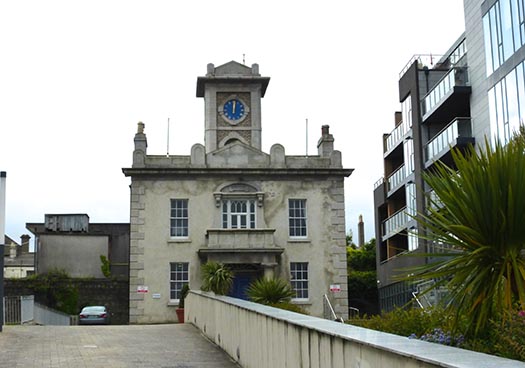
The Harbour Lodge is symbolic of today's Dun Laoghaire, a classical building from an earlier age, but now enclosed by modernity. Photo: W M Nixon
When we get down to the nitty gritty like this, Gerry Dunne is in his element. He's an affable guy, and good company, but I wouldn't like to get into a row with him, as there's steel underneath it all. So in the sedate setting of Harbour Lodge – which he cheerfully admits his opponents and friends have nick-named "Mussolini's Palace" – he's just the man to fight off the brickbats and work his way towards several objectives. But although he actually lives in Dun Laoghaire within walking distance of his office, he's not really into boat and water sports, yet that's no drawback, as personal preferences definitely don't come into it at all as he plans the way ahead.
He makes no bones about admitting that his attitude is strongly commercial. Before taking over the reins at Dun Laoghaire Harbour Company, he was Commercial Director at RTE, a job description which boggles the mind. Before that, he honed his skills in the UK, working for several large Irish food companies. If that gives you a vision of ditzy little artisan cheeses selling in agreeable country shops, then perish the thought – the big Irish food industries provide as tough a business environment as you could imagine.

The many moods of Gerry Dunne.Toughened by a varied and demanding career in business and marketing, he has brought a fresh mind to the problems of making Dun Laoghaire harbour economically viable. Photos: W M Nixon
He joined the Harbour Company in 2009, when talk of Stena's withdrawal was already in the wind. So he got Dun Laoghaire moving towards the cruise liner market in a small way, with the miniature 53-passenger Quest in 2011. Finding Quest an in-harbour berth was no problem, and she provided invaluable information on what Dun Laoghaire can provide as a USP for discerning cruise liner passengers. For Quest's rather specialist group, it was the easy access to the Wicklow Hills and particularly Mount Ussher Gardens, and they definitely didn't want to have to travel through Dublin City to get there.

The mini liner Quest – seen here in the Arctic - began the programme of attracting cruise ships to Dun Laoghaire in 2011
So far so good, but Gerry Dunne really struck gold when he started going to the cruise liner fairs in America and Europe. Gradually he built up a useful network, and again he struck gold when he got a report on the potential attractions of Dun Laoghaire from the Vice President (Itineraries) of one of the biggest American cruise liner conglomerates. Asked to sum up in one word the attraction of the Dun Laoghaire for visitors coming in from sea, her answer was: "Serenity".
We've become accustomed to Venice being talked of as The Most Serene Republic - The Serenissima. But it makes you sit up and take notice to hear of Dun Laoghaire being so described by a tough American businesswoman. Yet that's the impression the waterfront area, with its combination of the old yacht clubs, the station, the Town Hall and the Royal Marine Hotel, apparently makes on seaborn visitors from cruise liners, even if their liners are at present anchored outside the harbour and they have to be ferried in to land by ship's tenders. It seems they can blank out the less attractive buildings, and are left with the abiding impression of relaxed elegance with an easygoing way of life.
This takes a bit of getting used to, as it's so much at variance with the perception in Ireland of Dun Laoghaire as a place where they'd argue over anything and everything all the time, while just up the street there's the real problem of the dreary array of boarded-up shops. But like it or lump it, here it is folks – the reality is the yacht clubs and other other historically significant and stylish buildings of the Dun Laoghaire waterfront area – including the pleasantly under-stated Victorian residential terraces - are the town's greatest tourist asset.
Quite what some of the more senior members of the yacht clubs will make of that we can only guess, but the word is that the clubs have indicated that they'll be prepared to welcome some cruiser liner guests to their premises at pre-arranged times. So perhaps we should see the cruise liners as no more than extra-super super yachts......And there's no doubt that many rugged sailing folk from Dun Laoghaire are themselves only too happy to tootle off on a cruise liner when the peak of the sailing season is over.
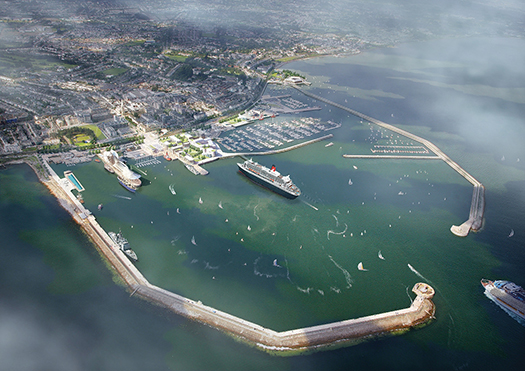
The artist's impression was just that – an artist's impression. If the new berth goes ahead, cruise liners will actually have their sterns towards the town.
But what is the reality if the new berth is agreed? Well, you can forget about your artist's impressions showing a liner facing the town. Space will be restricted, so the liners will come in stern first, thereby enabling them to make an elegant departure for the benefit of crowds down the end of the piers, which could become a popular occurrence.
The new liner pier will be as short as possible, though it will have an underpass for small craft, while the bows of the ships themselves will be held in place by dolphins, as was the HSS ferry. If you think that getting into this berth will involve impossibly ticklish manoeuvring, consider this recent photo of the three Cunard Queens up close and friendly in Southampton, and note that there's no lack of small craft nipping about among them.
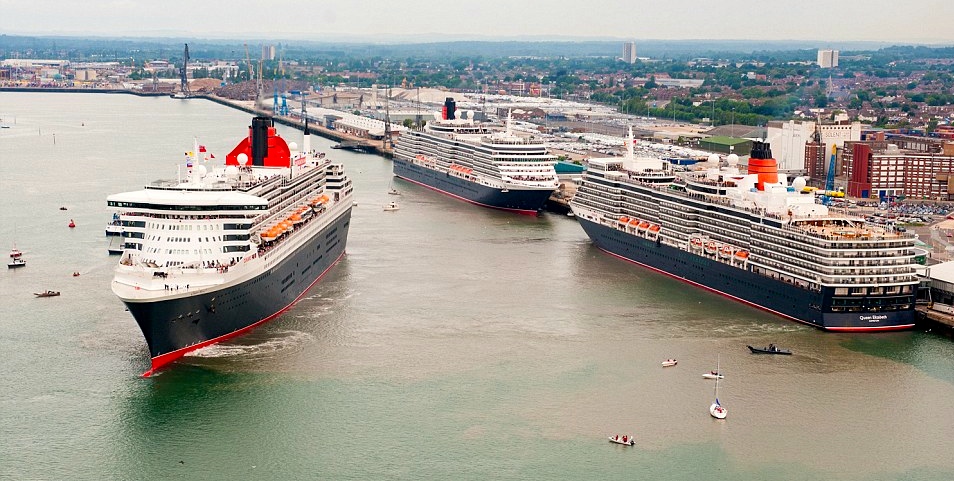 The three Cunarders can manoeuvre unaided at close quarters even with several small craft nipping about their heels, as seen here in Southampton
The three Cunarders can manoeuvre unaided at close quarters even with several small craft nipping about their heels, as seen here in Southampton
One of the other drawbacks about the current setup, with the ships anchoring off and people disembarking in the Coal Harbour, is that there's very little space for buses to move about, but the present waterfront marshalling yard left behind by the exit of Sealink will greatly relieve that problem if the new berth is built. At the moment, it is planned that passengers will walk the short length of the pier to reach their buses, but my own feeling is that the pier should be made a bit wider with a turning circle in order that passengers may board their buses almost directly from the ship, for we're not talking long distance athletes here.
That said, those who are fitter can come and go as they please, with the town within easy reach, whereas being anchored off can cause cabin fever. In other words, if Dun Laoghaire is going to have a cruise liner berth, let it be done properly – half measures involving long walks to buses just won't do, but equally for those who do walk, the town must feel accessible and welcoming.
As to the amount of space the ship will take up in the harbour, that will vary from ship to ship, but some are indeed enormous. And their wind-deflecting presence will certainly add an extra interest to in-harbour dinghy racing. As for the interest of the in-harbour racing for the visitors on the ship, that in turn will all be part of Dun Laoghaire's colourful charm, for which their ship will provide a grandstand view.
In line with that, we should remember that the leading in-harbour class, the historic Water Wags, have only just returned from showing themselves off at Morbihan Sailing week in France. Thus they'll scarcely be unduly bothered about providing a source of fascination for passengers on cruise liners, some of whom will probably be former dinghy racers themselves.
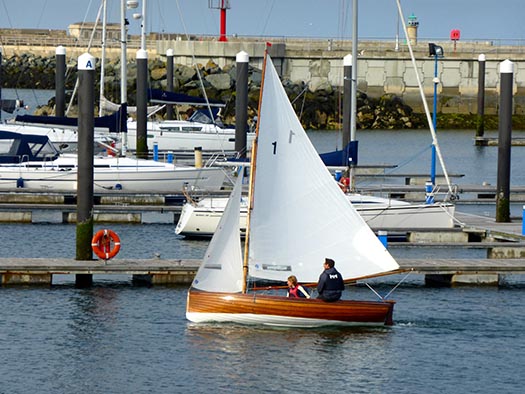
The Water Wags find it easy to sail freely within Dun Laoghaire Marina on their way out to race in the main harbour, so their only problem with a cruise liner berthed in mid-harbour will be the effect it has on wind flow. Photo: W M Nixon
But what the in-harbour dinghy racers are already becoming happily accustomed to is the newly-emptied eastern half of the harbour, with space now provided where boats used to moor. And this area will not be at risk from maneuvering cruise liners – there's not the depth for them. Finally, as to the height or otherwise of the ships in relation to other structures in Dun Laoghaire, I think we've been righteously indignant about this on a mistaken premise – since the new library was pushed into place, all bets about skyline heights and an elegant relationship with other waterfront buildings are clearly off.
So if the sailing and boating community can be more accepting of the cruise liners which will ultimately provide a real source of income to maintain the harbour which makes their activities possible, what can they expect in return?
They're in a strong negotiating position. After all, the Harbour Company's research has shown it is the comfortable presence of the yacht clubs which underpins this vision of serenity which is Dun Laoghaire's most appealing attraction for the kind of people who enjoy the cruise liner experience. So it's very much in the Harbour Company's interest to keep the clubs in good health.
By today's standards, the Royal Irish YC is thriving, thanks in no small part to its location within the marina against whose creation, ironically, the club fought tooth and nail. But the other three clubs – the Royal St George, the National, and the Dun Laoghaire MYC – are blighted by the limited and relatively unsheltered pontoon berthing at their clubhouses.
It may well be – and I'm only guessing – that the Marina Company's agreement with the Harbour Company includes a clause that these three clubs are not allowed to have their own adjacent marinas. But if such a clause exists, then it should be deleted for the greater good of the harbour and the vitality of the waterfront in general, and the three clubs should be facilitated in providing 150-boat marinas – with proper breakwaters for the George and National - in front of each clubhouse.
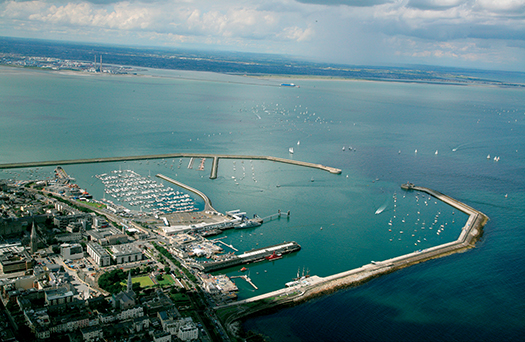
Dun Laoghaire from the southeast. If the new cruise liner berth is installed at mid-harbour, a longterm plan could be the installation of breakwaters in front of the Royal St George YC and the National YC in the foreground to shelter two new 150-boat marinas, as the location of the Royal Irish YC within the main marina gives it an unfair advantage in providing facilities for its members.
As to how Dun Laoghaire town can benefit, that's another matter altogether. The much stronger income and improved employment going through the Harbour Company will undoubtedly be a tangible good, though how seasonal it will be – with liners expected only between April and October – remains to be seen.
But personal expenditure by cruise liner passengers in the town is an imponderable. In fact, some cruise liners in the popular sunshine destinations are notorious for disembarking guests who feel that they made their total investment with the purchase of the ticket back home, so they don't plan to spend any more.
The historic little Venetian city-port of Dubrovnik on the Adriatic – which doesn't have a proper liner port – recently banned cruise liners from coming anywhere near the place, as their thousands of passengers made the narrow streets very uncomfortably crammed at peak times, yet the average expenditure ashore in Dubrovnik by each cruise liner passenger was precisely €6. There's food for thought. But we will of course get a better class of cruise liner passenger in Dun Laoghaire...
#queenmary2 – 'What is the name of the big, blue ship off Dun Laoghaire?' might well be a common Google search next Wednesday, May 20th when the Queen Mary II anchors off Scotsman's Bay at 7am. Interest in cruise liners was at a high this week for the start of the Cruise Ship season into Ireland when Royal Princess Cruise Liner passengers were welcomed at Dun Laoghaire on Tuesday and equally on Monday when the longest ever ship, the MSC Splendida cruise liner docked in Dublin Port.
RMS Queen Mary 2, the world's largest ocean liner made her maiden visit to Dublin Bay a year ago and returns almost a year to the day into Scotsman's Bay next Wednesday.
Another five star welcome is in store for some 3,000 passengers who will be greeted by a piper and Irish dancers, tour guides, free wireless and business offers after docking at the Coal Harbour.
The RMS Queen Mary II is the second of a flotilla of more than 20 floating visitors to Dún Laoghaire this year, bringing over 100,000 cruise passengers. This compares with just 200 passengers arriving in the harbour in 2012.
RMS Queen Mary II departs Dun Laoghaire just before low tide at 6pm next Wednesday.
Coal Harbour Users Group (CHUG) Seek Public Marine Leisure Centre at Dun Laoghaire Harbour
#chug – The Coal Harbour Users Group (CHUG) is a group that represents the interests of leisure users of the Dun Laoghaire Harbour & Boatyard, and also the interests of the public that use the resource. Consistent with this, CHUG wish to promote marine related leisure and sport activity for the "ordinary person" in the Dun Laoghaire area and in Dublin Bay. During April 2015, CHUG made a submission to the Dun Laoghaire Cruise Stakeholder Group relating to the proposed new ships berth within the harbour. Part of the submission suggested development of a Marine Leisure Centre in the area west of the West Pier, and suggested that some of the spoil that would result from proposed harbour dredging be used to reclaim and extend land there to accommodate the development.
Kevin Woods writes that CHUG members have viewed the DLR Draft County Development Plan 2016-2022. In the context of the plan, CHUG make the following comments and requests:
CHUG request that the area immediately west of the West Pier including the area known as "The Gut" be designated for marine pleasure, leisure, sport and education use. The development would principally include:
A public marine leisure centre operated along the lines of a municipal leisure centre. This is detailed below.
A new public slip suitable for use by small boats at all tides. There are few public slipways in the Dublin area, and of those, some are not usable at low tide. An additional slip would improve public accessibility to the water and to Dublin Bay in general.
Additional space for marine leisure use, including for storage and repair of small boats and equipment. This might be provided by land reclamation in the area shaded and marked (1) on the attached map.
While the above development appears to be in line with existing Draft Development Plan SLO 14 and SLO 95, these might be reviewed and revised as appropriate should this be necessary to carry out the above. This might be assisted by introduction a new SLO relating to the area marked (1) west of the West Pier along the lines of the following:
Objective to promote water related leisure, sport, education, training facilities for public use at the coastal fringe in the area know as The Gut to the west of the West Pier that may include the reclamation of land and also the development of a new breakwater projecting westward from the pier side. This proposal would be subject to a feasibility study, including an assessment of any options, access considerations and impact on adjoining users. The feasibility study would include appropriate environmental assessments including any required under the Habitats Directive in co-operation with the relevant agencies.
A Marine Activity Centre might include:
Club facilities - offices, store rooms.
Shared meeting room, training / education room, changing room / showers / WCs.
Drying room for wetsuits,
Diving equipment store room
Compressor room for filling diving cylinders.
Small boat repair workshop
Shelters for persons, equipment
Hardstanding for secure dinghy & rib parking, canoe / kayak, windsurf and paddle board storage, small craft trailer storage.
Car, coach / minibus parking.
The centre might also cater for:
Fishing, birdwatching, and nature related activity, and might be a base from which the following would be organised:
Training in water safety
Transition year and primary schools activities
Beach and marine nature, ecology, and environmental study activity.
Marine related art
Youth club facilities
A new scout den
A marine interpretive centre / marine history and heritage centre
#RoyalVisitor – Royal Princess at a commanding 142,000 tonnes is even larger than yesterday's Dublin Port record caller MSC Splendida, as this morning's latest caller made her maiden call off Dun Laoghaire Harbour by anchoring in Dublin Bay, writes Jehan Ashmore.
The 19 deck cruiseship christened by Catherine, Duchess of Cambridge almost two years ago at her UK homeport of Southampton had yesterday called to Cobh. This is where her sister Regal Princess was the first caller to dock last month after completion of phase one of Cobh's upgraded deepwater berth.She also became Belfast's biggest caller last year.
The work at Cobh Cruise Terminal is designed to accept RCI's mega sized 'Quantum' class 168,000 tonnes giants with almost 5,000 passengers in which the Port of Cork hope to attract in 2017.
It is the depth of water that restricts Royal Princess drawing 8.5 metres and those such as the 'Quantum' class from entering Dun Laoghaire Harbour.
The Dun Laoghaire Harbour Company have proposed a €18m single cruise-berth jetty as part of a 'masterplan'. The jetty would jutt out 435m and almost be in the centre of the south Dublin Bay port. The plans have been met with mixed reaction and in which An Bord Pleanala will review the planning application along with an Enviromental Impact Statement (EIS).
A similar process applies to Dublin Port Company's proposed €30m double-berth cruise terminal to enable much larger callers to dock closer to the city-centre.
As for the length of these 'next generation' cruiseships, MSC Splendida's 333 metres is a Dublin Port record and also pips the Royal newcomer by a mere 3 metres.
In the meantime Royal Princess launches the first of record 21 cruise callers this season to Dun Laoghaire bringing around 100,000 passengers and crew.
She had approached Dublin Bay from offshore via the Kish Lighthouse and North Burford before anchoring over a nautical mile of the harbour's East Pier, which offer some of the best vantage points as does Sandycove and Bulloch Harbour, Dalkey.
Royal Princess is deemed as one of the "Most Popular Ships at Sea" according to Cruise Critic and has already won five prestigious Travel Weekly Magellan Awards in the Large Ship, Atrium, Spa, Pool and Mobile App Design categories. A notably feature is the innovative SeaWalk which being hailed as one of the "Top Gee-Whiz Features at Sea" by USA Today!
Situated on top deck is the largest pool ever featured with Princess Cruises and an enhanced Movies Under the Stars screen. Those seeking a dizzying thrill, there's the aforementioned SeaWalk's of all 128 feet high offering a straight down vertical view!
Several decks below at the bow is where during this morning's anchorage procedures, a special Princess Cruises 50th anniversary flag was raised at the prow of the massive cruiseship.
As for another example of the ships dimensions, she has a breadth of 44 metres, that's four times that of the Naval Service CPV L.E. Orla (P41), a former Royal Navy coastal patrol vessel.
Her naval homeport of Haulbowline facing Cobh is where MSC Splendida today made her maiden call to Cork Harbour. She is one of the largest to visit Cobh noting the biggest albeit 'liner' status of Cunard's QM2 has called in more recent years. She made her Dun Laoghaire debut in 2013.
So when it comes to who is the Irish 'King' of the cruise crown title, this rests with RCI's Independence of the Seas of a whopping 154,000 tonnes which made her debut to Cobh in 2007.
Returning to the former Royal Navy CPV named HMS Swift she served the Hong Kong Patrol Squadron until transfer to the Naval Service in 1988. The CPV visited Southampton's neighbouring port of Portsmouth in 2013 where the RN's base nd HQ are located. Again the same year Royal Princess was commissioned into service to serve the expanding UK cruise market.
#dlharbour – Dun Laoghaire Harbour will receive its first cruise ship of the season at 6am tomorrow (Tuesday, 12th May) with the arrival of the Royal Princess voyaing up from Cork Harbour. It will remain in the Harbour for 12 hours before departing.
The Royal Princess was launched in 2013 and has a cruise / staff capacity of over 5,000 people. It is a new generation cruise ship and has the following dimensions:
Tonnage: 141,000
Length: 1,083 feet
Height: 217 feet
Last week the Dunlaoghaire Cruise Stakeholder Group – comprising the Harbour Company, Council and business stakeholders – launched a welcome programme which will be staged each day of a cruise call. The programme is aimed at increasing visitor interest in Dun Laoghaire and the wider hinterland.


























